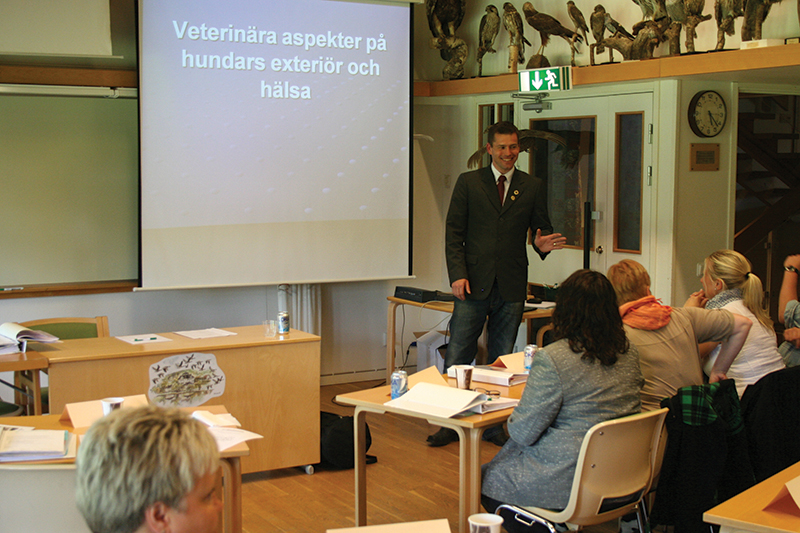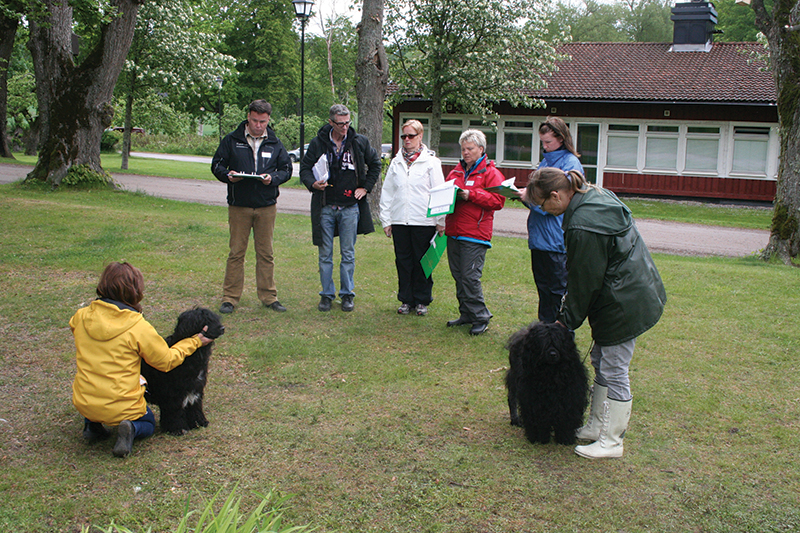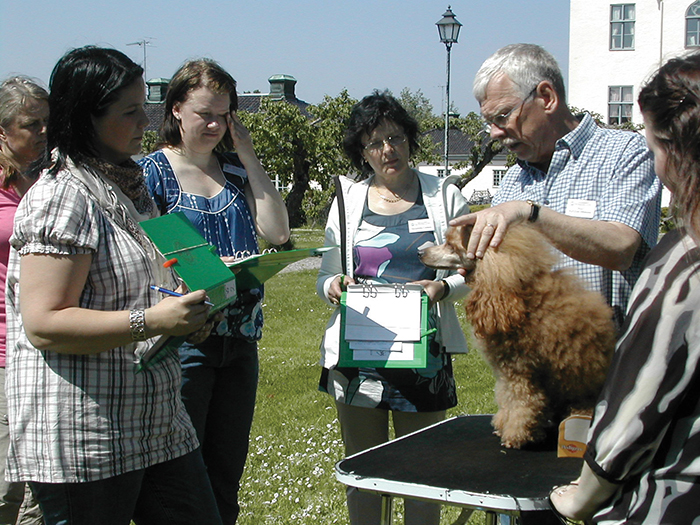How to become a Swedish K.C. judge? by Paul Stanton
Published in Best in Show Annual 2016
Each K.C. has its own regulations as to what is required to become a judge and I am of the opinion that the Nordic countries probably have the hardest regulations of all and the biggest problem for those that wish to become a judge is getting in to the judging scheme! In the UK it is not that difficult to become a judge in your own breed, you need to have been in your breed around 10 years or more in the popular breeds, bred or owned some winning dogs, worked on some committees and attended breed seminars but most important is the need to be patient and know the “right people”. This is obviously the case in many countries that of having the right contacts and was indeed so in my case as I had only been in Lhasa Apsos for 5 years when I first awarded CC.s in the breed but that was a special case as the breed was new with CC.s (first awarded in 1965) and I was welcomed with “open arms” as a young and enthusiastic person and helped enormously by the older breeders but that was way back then in 1975.
In Sweden there is no quick way to get in to the scheme and there are many requirements before you are accepted. You must have many years experience as a breeder and exhibitor at shows or hunting trials and working tests for those breeds that require tests to become champions. You must have passed your ring steward exams and have worked in the ring regularly, passed your exams in anatomy and rules & judging at courses arranged by the SKK. Once these “minor” issues are out of the way you are able to apply to the K.C. to become a judge, you have to fill in an extensive form about yourself and all that might be relevant for being accepted by disclosing your breeding, number of champions, imports, exports, hunting or working test winners, all other experience like judging at Open shows, attending special courses, languages etc. This form is then sent out to the breed/group clubs for the breeds you have applied for in your basic training which is from 1 to 5 breeds and you must write why you wish to start with these breeds and they are usually connected so that it would not be allowed to start with 5 different breeds from 5 Groups. These clubs along with your County K.C. (I belong to Stockholm K.C. under the SKK) are asked to give their opinion on whether you would be a suitable candidate to start judges training, if there are more than one person applying for the same breeds the clubs are required to write in which order they wish to see the candidates (the K.C. uses this as reference only).

The application forms are returned to the Judges Committee (DK) who has a special group consisting of 4-5 judges and SKK personnel who out of the usual 50-60 applications invite around 22-25 for an interview; this same group conducts the interviews at the SKK head offices in Stockholm over 4-5 evenings and when all have been interviewed this group selects around 15-16 with a maximum of 18 to start the Preparation course usually held in May every second year. The course starts on a Sunday afternoon with a repeat of anatomy, explaining what is expected of them, question and answer time and showing them a film of dog types which are too extreme and unhealthy. Monday starts off slowly with the students being divided in to 4 groups and each group goes to 1 of the rings where there is a teacher/examiner and they are taught how to measure heights and start writing critiques on dogs but at this course we do not teach about breed type but dogs in general and the principles of good critique writing and also giving spoken critiques. Each group is changed for each pass morning and afternoons with different dogs arriving for the pass so if a student is going to take 5 Group 9 breeds they are expected to write critiques for any breed that is in the ring, this is done so they learn to describe what they see and feel and it does not matter at all even if they do not know what the breed is! Each pass they are expected to judge more dogs and write critiques faster, the teachers are helping them with tips all the time on writing the critiques, ways to see and judge the dogs and what is important and what is less important. Every evening the teachers study all the critiques and discuss how each student is faring and on Wednesday evening each student is given a feedback as to what is excellent and what needs to improve. Friday is examination day when the teachers are divided in to 2 groups and the students come 1 at a time to the ring and is expected to judge 3 dogs of which 1 will be from a breed they have applied for and this dog they must know breed types and the other two dogs is a general description but they do not know what breeds will be in each ring. After final discussions the head teacher announces who has passed and at the last 5 or 6 courses all have passed as it is only the ones who the DK group feels will pass with a 99% chance that are invited whereas at earlier courses around 22-25 were present with always 5-7 who failed but this was considered unfair on the students and a waste of KC funds as the KC pay for all the students meals and hotel rooms and also the teachers and 2-3 KC staff.
Please do not think that these students are now judges as this is just the beginning of their training, they now have to go in the ring 3 times for the breeds they have applied for as a Pupil judge where they have to listen, learn and ask questions from the judge and not just under any judge but one that is from the Nordic countries, has judged the breed at least 5 times and been a judging for at least 5 years (special permission can be given for foreign breed specialists). When they have completed successfully one of their breeds 3 times they then become Student judges where they must write critiques on each dog in the ring and the judge can ask them questions about gradings and placings and will then assess them on their ability for each breed and check with his/her own critiques, if a student fails then he must go for another judge. As soon as a student has completed successfully 2 student exams then they are now official judge for that breed. These new judges cannot apply for new breeds until they have judged all the breeds of their original 1-5 and 2 years must have passed but only 8 breeds a year! Examinations can be done in 3 different ways, in the ring as first Pupil then student or after judging has finished make an examination under 2 judges, one proposed by the breed club and one by the SKK of which a minimum of 5 dogs must be present also sometimes the SKK will organize evening or weekend examinations when there are usually 3 or more wanting to take the same breed. To judge any breed which needs any kind of working test the student must participate in a test with an approved judge for these tests, so many of Group 1 breeds, Group 4, Group 5 Hunting Spitzes, Group 7 & 8 Gundog breeds that need a hunting test and this is done so that the student judge knows what is required in a breed and that it is correct for the function that it was designed for. To become a Group judge you must judge the 5 numerically largest breeds at shows plus 66% of that group so you can see it will take many years, usually at least 20 to become an All Breeds judge and this is not given automatically but is deemed an honour by the SKK and it is the Central Committee that authorizes this for a judge who has practical knowledge of judging all types of dogs, all different kinds of movements, all types of coats and most important to be a respected as a person and judge both nationally and internationally.

Torbjörn my partner of 35 years is now completing special exams to become an All Breeds judge and the DK gave him a special list of breeds which he needed to take exams in and some of the breeds were a very strange choice in my opinion, of course he had to take most of the Swedish national breeds which nearly all require Hunting tests but to find shows with Norrbotten Spitzes (a hunting Spitz that barks when it has found its game) entered is not easy so he will fly to the North of Sweden where the breed originates from and is more easily found in adequate numbers to attend a show. Torbjörns´ list is gradually getting smaller and hopefully by the time you read this he will be an All Breeds judge after 23 years of judging.
In 2016 I will celebrate 20 years as an All Breeds judge for the SKK but my regulations were a little different as I had completed nearly 150 breeds by examinations or receiving some free as they were minority breeds but was informed by the DK that they wanted to propose me to be an Allrounder but I did not have enough breeds in Group 5,6 & 7 so I was told to concentrate on those groups and after 1½ years I received a letter from the SKK that I had become an All Breeds judge much to my delight although this was never something I dreamed of! In later years we had some new Allrounders but they did not have to complete anything special but now at least the DK have made new regulations that are fair (?) so those being proposed know what is expected of themselves. It has always been difficult to become an All Breeds judge in any of the Nordic countries as it is in Holland, France and Germany and some other countries which is probably the reason you can hear a lot of disgruntled comments when we see Allrounders being appointed after only a few years of judging experience and it is not rare that it is contacts more than experience that paves the way for some especially in countries where there are not so many breeds registered or shown. Thankfully the Nordic KC.s realize this and that is why we are seeing more All Breed judges coming from these countries but again there is no short cut!

File Size : 394.4KB (403879 Bytes)
Date Taken : 0000/00/00 00:00:00
Image Size : 1600 x 1200 pixels
Resolution : 300 x 300 dpi
Bit Depth : 8 bits/channel
Protection Attribute : Off
Hide Attribute : Off
Camera ID : N/A
Camera : E775
Quality Mode : NORMAL
Metering Mode : Matrix
Exposure Mode : Programmed Auto
Speed Light : No
Focal Length : 9.7 mm
Shutter Speed : 1/171.5 second
Aperture : F10.0
Exposure Compensation : 0 EV
White Balance : Auto
Lens : Built-in
Flash Sync Mode : Red Eye Reduction
Exposure Difference : N/A
Flexible Program : N/A
Sensitivity : Auto
Sharpening : Auto
Image Type : Color
Color Mode : N/A
Hue Adjustment : N/A
Saturation Control : N/A
Tone Compensation : Normal
Latitude(GPS) : N/A
Longitude(GPS) : N/A
Altitude(GPS) : N/A



